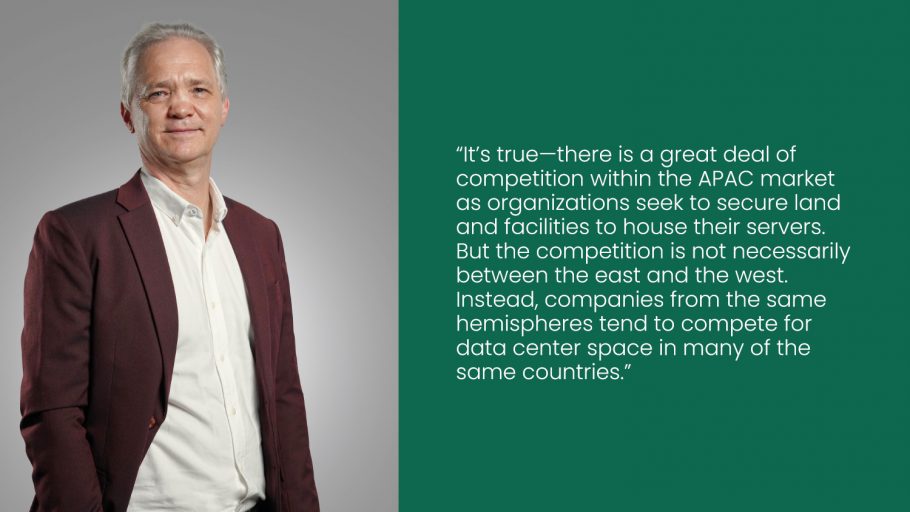Asia Pacific (APAC) continues to prove itself as one of the world’s hottest data center markets. A recent report by Cushman & Wakefield showed hundreds of megawatts of capacity across some of the region’s largest population centers, including Hong Kong, Singapore and others with low data center vacancy rates throughout the area.
Growth in the region has significantly accelerated thanks to pervasive connectivity. Today, everywhere and everything in APAC is connected—from markets and stores (where payment via QR codes using Alipay or WeChat Pay are routine), to homes (where there are few landlines but many smartphones), to workplaces (particularly during the age of lockdowns that established the need to work remotely and sell traditional goods and services online).
Let’s look at the driving forces behind the growing demand and competition for data centers in APAC, why many companies are choosing colocation over self-build and the three things you should look for when considering an APAC data center partner.
THREE DRIVING FORCES OF APAC DATA CENTER DEMAND
Who is connected, who is connecting to them and why? The answers to those questions provide a good perspective on what’s driving data center demand in APAC.
There are three primary forces at play that combine to make the region unique:
A technology-savvy demographic. Indeed, Singapore is routinely ranked as the most technology literate country (and has recently been cited as one of the top data center markets in the world), while Indonesia’s Facebook user base is among the highest and most engaged globally. Smartphone ownership is extremely high throughout the entire region; according to GSMA, 1.8 billion people will subscribe to mobile services by 2025. Citizens around APAC have a growing expectation to do everything through their smartphones.
Massive user bases. Four of the top ten countries by population are in APAC, including two with populations numbering in the billions (see graphic). That translates into massive numbers of users consuming an extraordinary amount of data.
Rising demand for cloud services. In a region totaling more than half of the world’s population, the steady rise in popularity of mobile applications for everything from finance to e-commerce and gaming has spurred a huge appetite for cloud services in APAC. This has opened data center doors for e-commerce giants like Alibaba, JD.COM, Shopee and others. Additionally, the western hyperscale cloud providers already have well established presence in the Tier 1 APAC markets and are rapidly deploying footprints to the multiple Tier 2 locations across APAC.

AN EAST VS. WEST COMPETITION-OR SOMETHING ELSE?
Data center vacancy rates in APAC are typically low, particularly compared to the rest of the world. To put things in perspective, vacancy rates in the equally hot Toronto market are about 10.4%, compared with a rate of about 7.5% across Hong Kong, Singapore and Sydney.
Given the lack of inventory and the size and opportunity the region presents, you might assume heavy competition between Eastern-based companies and Western-based organizations to secure capacity within the region. It’s true—there is a great deal of competition within the APAC market as organizations seek to secure land and facilities to house their servers. But the competition is not necessarily between the east and the west. Instead, companies from the same hemispheres tend to compete for data center space in many of the same countries.
For instance, the biggest population centers—Hong Kong, Tokyo and Singapore—tend to be dominated by western hyperscalers. Large western hyperscalers such as AWS, Microsoft and Google established a presence early in the Tier 1 markets and have used these locations as regional hubs to service the populations within these and surrounding countries.
Eastern-based providers tend to come in at a smaller scale, preferring to take a targeted, regional approach. This allows them to get very close to the markets that are most important to their businesses. They will establish a presence in markets with large populations and synergies across their e-commerce and cloud service offerings. For example, Alibaba has strong e-commerce offerings with AliExpress and Tmall as well as a strong cloud offering through Alibaba Cloud.
COLOCATION DATA CENTERS ENABLE COMPANIES TO SCALE ACROSS APAC
As such, instead of buying up swaths of land and placing a huge data center in a single location, many companies entering APAC are interested in building multi-market footprints. They may opt to have a presence in multiple locations to allow access to a broad range of markets as a ‘local’ supplier.
ABOUT THE AUTHOR
Brian Groen leads Vantage’s business across Asia Pacific. With nearly 40 years of experience, Groen is a seasoned executive with an extensive background in data centers, public cloud, storage and managed services. Prior to Vantage, Groen was senior vice president of Data Centre and Digital Transformation, a division of PCCW Solutions Limited that was acquired by Vantage. In this role, Groen led the development and delivery of multiple data centers, increased data center occupancy by nearly 50% and grew data center revenue by more than fivefold in just five years. Earlier in his career, Groen spent more than 20 years at IBM where he held several senior positions in Hong Kong, China, Australia and New Zealand.



